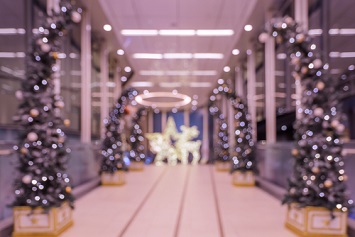By itself, winter carries a heightened risk of fire, because it involves more of the things that create warmth and light—fireplaces, space heaters, candles, cozy blankets. During the holidays, even more light, heat, and potentially flammable decorations are added to that mix.
During the holidays, enjoy your cheerful decorations without creating a fire hazard by keeping these tips in mind.
Holiday Lights
All those twinkly lights are electrical, and they can also be hot. Both of those things make them a potential source of ignition if they’re not used with care. Protect against fires caused by plugged-in decorations by:
- Choosing decorations that are UL listed,
- Choosing decorations with fuses built into their plugs, and
- Inspecting both old and new cords and plugs for broken or cracked sockets, frayed or bare wires, or loose connections.
Holiday Decorations
Christmas trees—both real and artificial—are involved in more than 200 fires each year, according to the National Fire Protection Association. Make sure your decorations aren’t creating a hazard by ensuring that:
- Artificial Christmas trees used in the workplace are labeled “fire resistant.”
- Lights that generate large amounts of heat are not placed alongside flammable or combustible materials, such as wreaths.
- Areas where flammable or combustible gases or vapors may be present are not decorated (no holiday lights on the propane tank!).
- Avoid overloading electrical circuits, which can create a fire hazard, by checking the documentation that comes with your decorations. You may find that you need to:
- Limit the number of cords strung in series (for example, many strings of Christmas lights recommend that no more than three strings be connected to each other).
- Avoid connecting decorations in series so that a decoration that draws more power is pulling power through a decoration that is designed to operate at a lower voltage, overloading the smaller-gauge cord.
- Avoid overloading your building’s electrical circuits.
- Avoid overloading any extension cords you use.
Other Ignition Sources
In addition to electricity, ignition sources that may be more common during winter and/or the holidays include:
- Fireplaces. If you use a fireplace, make sure it is properly inspected and cleaned each year.
- Space heaters. Workers may bring space heaters for their cubicles or offices; you may wish to place restrictions or safety rules in place to address these.
- Candles. Holiday candles can be festive, but candles are also a major source of fires. Again, you may need to put rules in place regarding candles.
Emergency Egress and Equipment
Another fire hazard that can crop up during the holidays is the failure to maintain emergency access and egress. Make sure, during the holidays, that:
- Fire exit doors are kept clear and unobstructed. Don’t decorate fire exit doors.
- Hallways leading to fire exits are kept clear and unobstructed.
- Walkways are kept free of tripping hazards (holiday decorations and cords).
- Clear access is maintained to fire extinguishers, fire alarm pulls, first-aid kits, automatic external defibrillators, and other safety equipment.
- A clearance of 18 inches is left around sprinkler heads.
- Decorations are located a safe distance from electrical panel boxes and heat sources.
Tomorrow, we’ll discuss holiday electrocution hazards.

